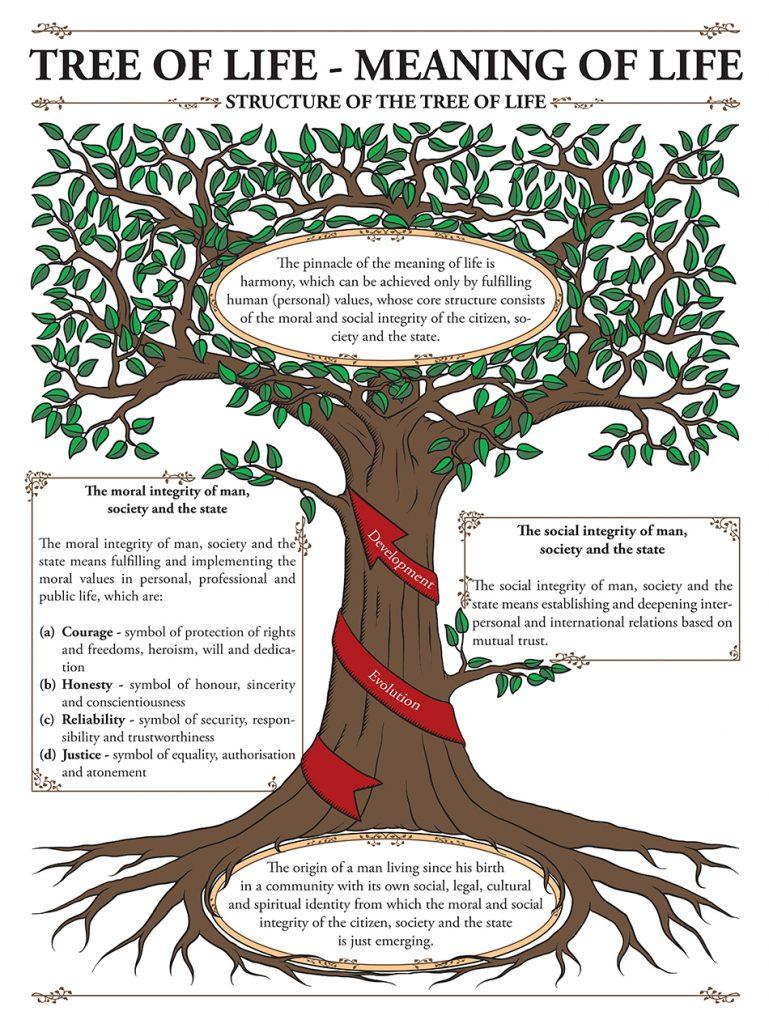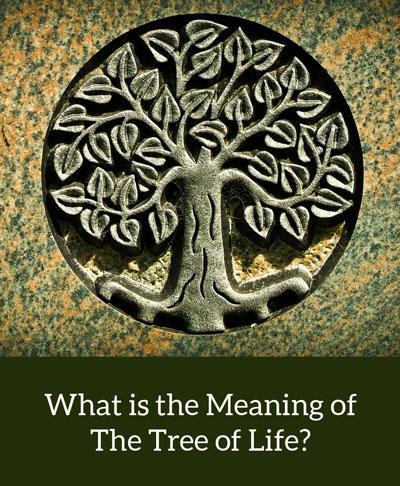The Tree of Life is a popular and universal symbol that represents multiple different things across various cultures and religions. The symbol does not belong to one specific culture as it has been used all over the world for centuries.
The tree is seen as a sacred symbol, which carries significant meanings in both religious and spiritual philosophies. While the Tree of Life symbolizes many different things, there are some common themes that the symbol represents within multiple cultures.

THE MEANING OF THE TREE OF LIFE
A Connection to Everything
The Tree of Life commonly represents the interconnectedness of everything in the universe. It symbolizes togetherness and serves as a reminder that you are never alone or isolated, but rather that you are connected to the world. The roots of the Tree of Life dig deep and spread into the earth, thereby accepting nourishment from Mother Earth, and its branches reach up into the sky, accepting energy from the sun and moon.
Ancestry, Family, and Fertility
The Tree of Life symbol also represents the connection to one’s family and ancestors. The Tree of Life has an intricate network of branches that represents how a family grows and expands throughout many generations. It also symbolizes fertility as it always finds a way to keep growing, through seeds or new saplings, and is lush and green, which signifies its vitality.
Growth and Strength
A tree is a universal symbol of strength and growth as they stand tall and strong all over the world. They spread their roots deep into the soil to ground and stabilize themselves. Trees can weather the toughest of storms, which is why they are such a prominent symbol for strength. The Tree of Life represents growth as a tree starts out as a small, delicate sapling and grows over a long time into a giant, strong tree. The tree grows up and outwards, representing how a person grows stronger and increases their knowledge and experiences throughout their lifetime.
Individuality
The Tree of Life symbolizes one’s individuality as trees are all unique with their branches sprouting at different points and in different directions. It symbolizes a person’s personal growth into a unique human being as different experiences shape them into who they are. Over time, trees gain more unique characteristics, as branches break off, new ones grow, and as the weather takes its toll – all throughout which the tree remains strong and sturdy. This is a metaphor for how people grow and change throughout their lifetime and how their unique experiences mold them and enhance their individuality.
Immortality and Rebirth
The Tree of Life is a symbol for rebirth as trees lose their leaves and seem to be dead during winter, but then new buds appear and new, fresh leaves unfurl during the spring. This represents the beginning of a new life and a fresh start. The Tree of Life also symbolizes immortality because even as the tree grows old, it creates seeds that carry its essence so it lives on through new saplings.
Peace
Trees have always evoked a sense of calm and peace so it is unsurprising that the Tree of Life is also a symbol for peacefulness and relaxation. Trees have a relaxing presence as they stand tall and still while their leaves flutter in the breeze. The Tree of Life serves as a reminder for the unique, calming feeling that one gets from trees.
THE HISTORY OF THE TREE OF LIFE SYMBOL
As a symbol, the Tree of Life goes all the way back to ancient times. The oldest known example was found in the Domuztepe excavations in Turkey, which dates back to about 7000 BC. It is believed that the symbol spread from there in various ways.
A similar depiction of the tree was discovered in the Acadians, which dates back to 3000 BC. The symbols depicted a pine tree, and because pine trees do not die, the symbols are believed to be the first depictions of the Tree of Life.
The Tree of Life also has strong significance to the Ancient Celts. It represented harmony and balance and was an important symbol in the Celtic culture. They believed it had magical powers so when they cleared their lands, they would leave one single tree standing in the middle. They would hold their important gatherings under this tree and it was a very serious crime to cut it down.
Origins
There’s no question that the Tree of Life’s origins pre-date the Celts as it is a powerful symbol in Ancient Egyptian mythology among others. There are various designs associated with this symbol but the Celtic version dates to at least 2,000 B.C. This is when carvings of the design were found in Northern England during the Bronze Age. Obviously, this also predates the Celts by over 1,000 years.
The Norse Legend of the World Tree – Yggdrasil. The Celts may well have adopted their Tree of Life symbol from this.
It would appear as if the Celts adopted their Tree of Life symbol from that of the Norse who believed the source of all life on Earth was a world ash tree they called Yggdrasil. In the Norse tradition, the Tree of Life led to nine different worlds including the land of Fire, world of the dead (Hel) and the land of the Aesir (Asgard). Nine was an important number in both Norse and Celtic cultures.
The Celtic Tree of Life varies from its Norse counterpart in terms of its design which is folded with branches and forms a circle with the tree’s roots. If you look closely, you’ll notice that the design is pretty much a circle with a tree in it.
Meaning
According to the Ancient Celtic Druids, the Tree of Life possessed special powers. When they cleared an area for the purposes of settlement, a single tree would be left in the centre which became known as the Tree of Life. It provided food, warmth and shelter to the population and was also an important meeting place for high ranking members of the tribe.
As it also provided nourishment to animals, this tree was believed to take care of all life on Earth. The Celts also believed that each tree was an ancestor of a human being. It is said that Celtic tribes would only inhabit locations where such a tree was present.
The Assyrian/Babylonian (2500 BC) idea of the Tree of Life, with its nodes is similar to the Celtic Tree of Life.
During wars between tribes, the biggest triumph was to cut down the opponent’s Tree of Life. Cutting down your own tribe’s tree was deemed to be one of the worst crimes a Celt could commit.
Symbolism
Perhaps the central tenet of the Tree of Life is the idea that all life on Earth is interconnected. A forest is made up of a large number of individual trees; the branches of each one link together and combine their life force to provide a home for thousands of different species of flora and fauna.
There are actually a number of things the Tree of Life symbolizes in the Celtic tradition:
- Since the Celts believed humans came from trees, they viewed them not only as living being but also as magical. Trees were guardians of the land and acted as a doorway to the spirit world.
- The upper and lower worlds were connected by the Tree of Life. Remember, a large proportion of a tree is underground so according to the Celts, the roots of the tree reached into the underworld whereas the branches grew to the upper world. The tree trunk connected these worlds with the Earth. This connection also enabled the Gods to communicate with the Tree of Life.
- The tree symbolised strength, wisdom and longevity.
- It also represented rebirth. Trees shed their leaves in the autumn, hibernate in the winter, the leaves grow back in the spring and the tree is full of life in the summer.
In Egyptian mythology, there are references to the tree of life, and from beneath this tree the first Egyptian gods were born.
The Tree of Life in Other Cultures
As you know by now, the Celts were not the first people to adopt the Tree of Life symbol as something meaningful.
The Mayans
According to this Mesoamerican culture, a mystical mountain on Earth was hiding Heaven. A World Tree connected Heaven, Earth and the Underworld and grew at the point of creation. Everything flowed out from that spot in four directions (North, South, East & West). On the Mayan Tree of Life there is a cross in the centre which is the source of all creation.
Ancient Egypt
The Egyptians believed that the Tree of Life was the place where life and death were enclosed. East was the direction of life whereas West was the direction of death and the underworld. In Egyptian Mythology, Isis and Osiris (also known as ‘the first couple’) emerged from the Tree of Life.
Christianity
The Tree of Life is featured in the Book of Genesis and is described as the tree of the knowledge of good and evil which was planted in the Garden of Eden. Historians and scholars are unable to agree on whether it is the same tree or separate ones. The term ‘Tree of Life’ appears another 11 times in subsequent books of the Bible.
China
There is a Taoist story in Chinese Mythology which describes a magical peach tree that only produces a peach ever 3,000 years. The individual who happens to eat this fruit becomes immortal. There is a dragon at the base of this Tree of Life and a phoenix on top.
Islam
The Tree of Immortality is mentioned in the Quran and is different from the Biblical account insofar as only one tree is mentioned in Eden which was forbidden to Adam and Eve by Allah. The Hadith do mention other trees in heaven and while the tree symbol plays a fairly minor role in the Quran, it became an important symbol in Muslim art and architecture and is also one of the most developed symbols in Islam. In the Quran, there are a trio of supernatural trees: The Infernal Tree (Zaquum) in Hell, The Lote Tree (Sidrat al-Muntaha) of the Uttermost Boundary and the Tree of Knowledge which is in the Garden of Eden. In the Hadith, the different trees are combined into one symbol.
Beyond a wholesome discipline, be gentle with yourself.
You are a child of the universe, no less than the trees and the stars; you have a right to be here. And whether or not it is clear to you, no doubt the universe is unfolding as it should.
Therefore be at peace with God, whatever you conceive Him to be, and whatever your labors and aspirations, in the noisy confusion of life, keep peace in your soul. With all its sham, drudgery and broken dreams, it is still a beautiful world.
Be cheerful. Strive to be happy.
